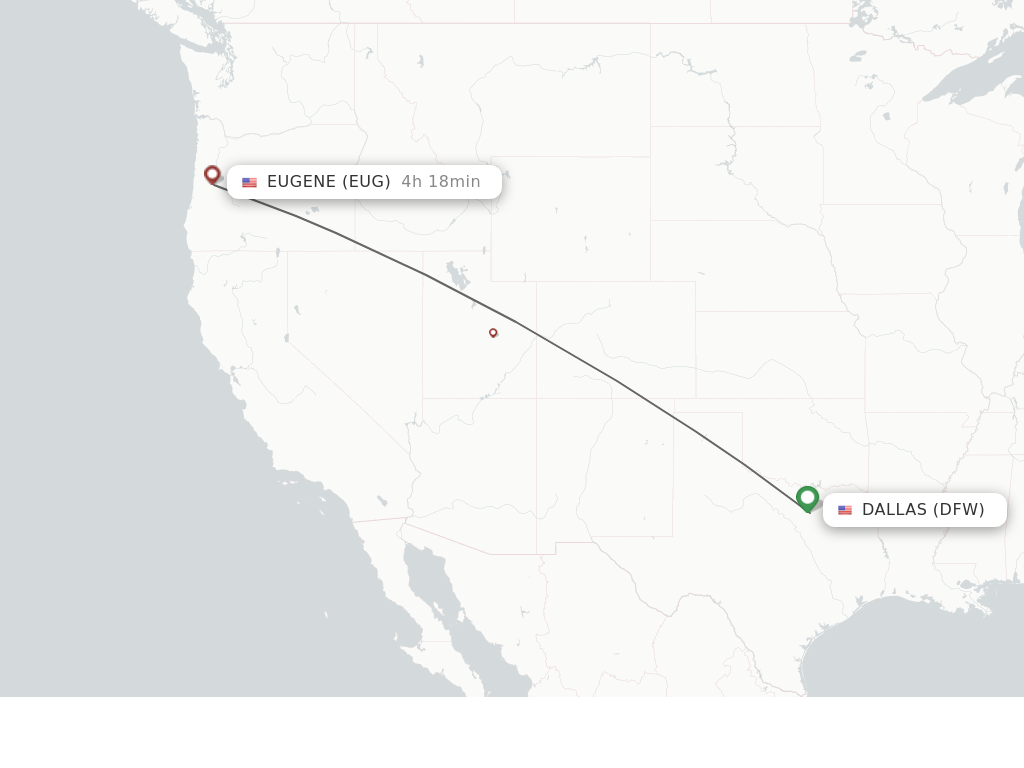American Airlines, one of the world’s busiest carriers transporting over 200 million passengers annually, has officially announced the permanent termination of its Dallas/Fort Worth (DFW) to Eugene, Oregon (EUG) route. The move is part of a broader network adjustment as the airline reassesses its service offerings, focusing on high-demand markets while trimming routes that no longer meet operational goals.
According to The Street, American Airlines operated more than 2.1 million flights covering 1.8 billion miles in 2024 alone. Despite this impressive scale, the airline has been striving to keep pace with competitors like Delta and United, particularly in profitability and premium passenger experience. While investments in upgraded lounges and refreshed cabin interiors aim to narrow this gap, not every route has made the cut.

Dallas–Eugene Route Grounded Permanently
The Dallas to Eugene connection, which launched in 2021, quickly became a reliable option for travelers moving between Texas and the Pacific Northwest. Initially, the route offered year-round service, but earlier this year, American Airlines scaled it back to a seasonal schedule. The final flight departed on August 5, 2025, and the route will not return in 2026, effectively ending four years of continuous operation.
“As part of a continuous evaluation of our network, American has made the difficult decision to discontinue service between Dallas Fort Worth (DFW) and Eugene, Oregon (EUG),” the airline stated in a formal announcement shared with The Street.
For passengers who have relied on this direct link, the change may pose logistical adjustments, especially for those traveling between the South, Midwest, and Oregon. While American Airlines still offers connections to Eugene via its Phoenix hub, the convenience of a direct flight from Dallas has now been removed.
Refunds and Alternative Options for Travelers
American Airlines is proactively reaching out to customers affected by the cancellation. A spokesperson told AirlineGeeks, “We’re proactively reaching out to impacted customers and apologize for any inconvenience.” Passengers who had booked flights on the now-discontinued Dallas–Eugene route will be offered full refunds or alternative itineraries, ensuring they can still reach their destinations without financial loss.
For many travelers in Oregon, losing the direct Dallas route will require planning new travel strategies. Passengers will either need to book connecting flights through hubs such as Phoenix or explore other carriers. The airline emphasized that while the direct connection is gone, Eugene will remain accessible through its network.
Understanding the Reasons Behind the Cancellation
Airlines constantly monitor their route networks for profitability and passenger demand. The decision to cancel the Dallas–Eugene flight is part of American Airlines’ ongoing evaluation of its operations. Several factors contribute to such decisions:
-
Passenger Load and Route Demand: Routes with inconsistent passenger volumes are more likely to be discontinued in favor of higher-demand connections.
-
Operational Costs: Fuel prices, staffing, and aircraft availability play a critical role in route viability.
-
Post-Pandemic Travel Trends: While leisure travel continues to recover, the rebound is concentrated in major tourist and business corridors. Smaller cities like Eugene haven’t seen the same sustained year-round traffic, leaving them more vulnerable to route cuts.
The airline’s seasonal adjustment earlier this year—reducing the route to limited service—often serves as an indicator that demand may be weakening. With Eugene still accessible via Phoenix, the airline maintains connectivity while reallocating resources to more profitable or higher-demand markets.

Wider Implications for Travelers
At first glance, the cancellation of a single route might seem minor. However, industry observers note that even small adjustments can have far-reaching consequences. When airlines reduce service to smaller or mid-sized cities, it often results in:
-
Fewer travel options for affected regions
-
Longer layovers due to limited connecting flights
-
Higher fares as competition decreases on remaining routes
Additionally, these route reductions can exacerbate operational challenges during disruptions. With fewer flights available to absorb delays caused by weather or staffing shortages, passengers may experience extended delays or more complicated rerouting.
American Airlines has not announced any further route suspensions at this time. However, with the current timing coinciding with winter schedule planning, more small-market adjustments could emerge. Across the United States, several airlines have recently revised seasonal routes, consolidated departures, and reassigned aircraft as part of cost-control measures and efficiency optimization.
How Passengers Can Adapt
Even if you aren’t directly affected by the Dallas–Eugene cancellation, these adjustments serve as a reminder to stay vigilant when booking flights, particularly from smaller regional airports. Travelers can take several steps to avoid complications:
-
Double-check itineraries: Confirm flights months in advance to ensure they remain on the schedule. Automatic rebookings from route removals can sometimes be less convenient.
-
Allow extra time for connections: With tighter schedules, missing a connecting flight can lead to longer delays than previously experienced. Avoid tight layovers whenever possible.
-
Consider flexible fares or travel insurance: These options provide protection if routes are canceled or schedules shift unexpectedly. Flexibility makes it easier to adjust travel plans.
-
Explore alternative airports: In regions like Oregon, checking nearby airports such as Portland or Medford can provide backup options. A short drive may open access to more stable flight connections.
By proactively managing travel plans, passengers can mitigate inconvenience and maintain smoother journeys even amid route reductions.
What This Means for the Airline Industry
American Airlines’ decision reflects broader trends in the U.S. aviation market. Carriers continue to recalibrate their networks in a post-pandemic environment, balancing operational costs with fluctuating demand. While major routes between large cities remain profitable, regional and mid-sized connections often face adjustments as airlines prioritize efficiency and resource allocation.
The cancellation also highlights a shift in travel patterns. Leisure travel is robust but concentrated in high-demand corridors like Florida, Hawaii, and international gateways. Meanwhile, cities like Eugene, which rely on a mix of business and leisure traffic, may not generate the consistent passenger loads needed to sustain direct connections.
For American Airlines, the choice to maintain service through Phoenix rather than Dallas allows the airline to optimize resources while keeping Eugene accessible. For travelers, however, the change underscores the importance of flexibility and early planning in 2025’s evolving travel landscape.
Looking Ahead
While the Dallas–Eugene route is ending, American Airlines’ approach demonstrates its commitment to operational efficiency and customer service. The airline’s proactive communication, offering refunds and alternative itineraries, ensures that passengers remain supported during network adjustments.
Travelers can expect more fine-tuning of routes, especially in markets served by limited daily flights. For now, Eugene residents and travelers will need to adapt by connecting through Phoenix or considering other carriers for direct access to the South and Midwest.
The cancellation serves as a timely reminder: in today’s aviation world, even established routes can disappear with little notice. Staying informed, monitoring schedule updates, and maintaining flexible travel plans are the best strategies for navigating changes efficiently.
With inputs from agencies
Image Source: Multiple agencies
© Copyright 2025. All Rights Reserved. Powered by Vygr Media.




















